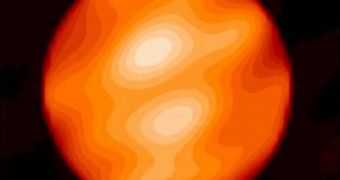Astronomers have recently managed to snap a new photo of the behemoth star Betelgeuse, which appears to resemble our own Sun in more ways than one. According to the recently released image, there are two very bright spots on the surface of the massive star, each of which is similar to corresponding structures on the Sun. Experts are amazed by this image, because it is the first time anyone has been able to demonstrate that Sun-like heat transportation systems exist under the surface of larger stars.
The new data seem to point at the fact that the two regions are areas where hotter material, rising from the star's core, reaches the surface, in very much the same way solar physicists on Earth are accustomed to seeing on our own parent star. But, in the case of Betelgeuse, there may be more to the bright spots than meets the eye. Experts show that the celestial body has been losing at least one solar mass of matter each 10,000 to 100,000 years, and that it will most likely continue to do so until it bursts into a supernova, or ends up like a black hole.
The star has been known to be losing mass for a long time, but now a group of astrophysicists even propose that the two bright spots may be related to the massive plume of hot gas that the star has been releasing for some time. They say that the two phenomena may be connected, although they admit no clear evidence to support that is available at this point. Betelgeuse is about 600 times the size of the Sun, and is estimated to weigh in at about 20 times our star's mass. It can be found on the right shoulder of the hunter in the Orion Constellation, some 600 light-years away from the Earth. It is currently classified as a red supergiant, Space reports.
“The situation on Betelgeuse seems pretty much different than in the case of the sun. The convective cells are far much larger,” Paris Observatory astronomer Guy Perrin says. He has also been a co-leader of the research team that conducted the new infrared observations. “The star has a patchy surface produced by a few convective cells. Now we need to better understand the physical properties of these cells to go further: their temperature, their lifetime, their connection to magnetic fields, etcetera,” he adds.
The other co-leader of the work has been PO astronomer Xavier Haubois. The group used three telescopes in Arizona for the observations. The instruments were tied together as an interferometer, which allowed for more precise observations than possible with any of them individually. Calculations also revealed that, while most of Betelgeuse's surface was heated to about 3,600 degrees Kelvin, the bright spots tended to be about 500 degrees Kelvin hotter.
“Betelgeuse may not be an isolated case and is not necessarily peculiar with respect to other stars of the same class. So we may anticipate similar cells on other red supergiants,” Perrin adds. Details of the work appear in the October 2009 issue of the respected scientific journal Astronomy & Astrophysics.

 14 DAY TRIAL //
14 DAY TRIAL //